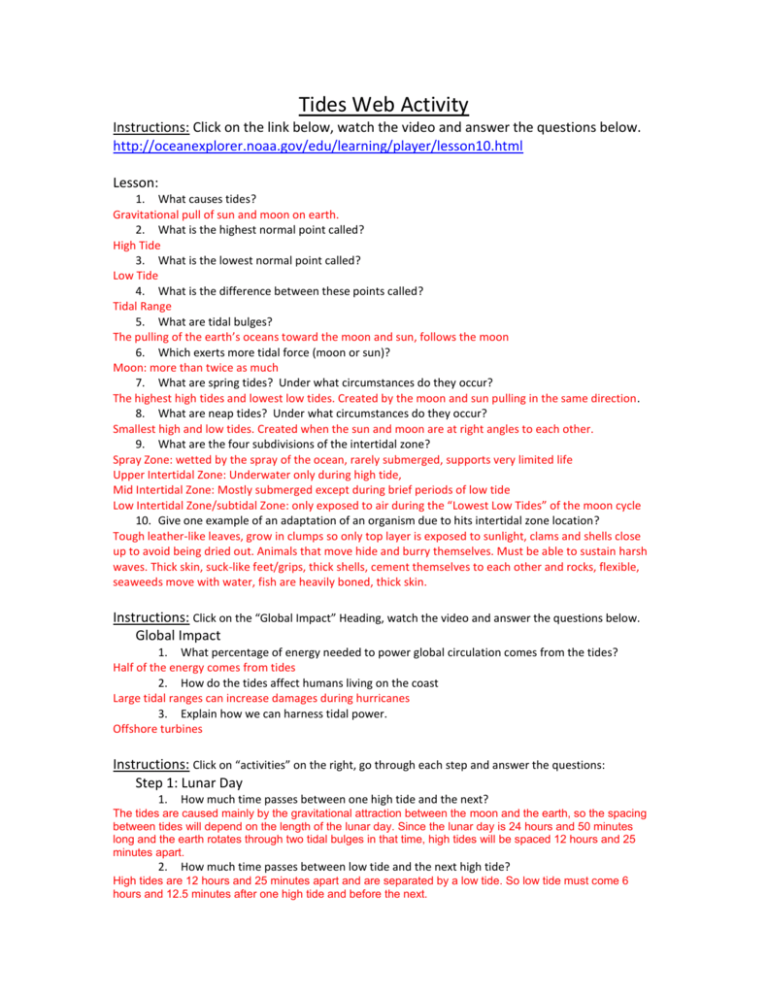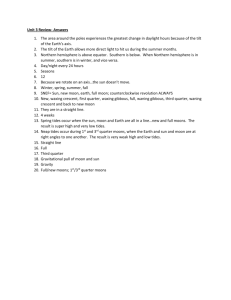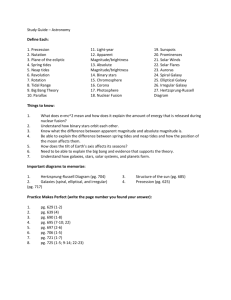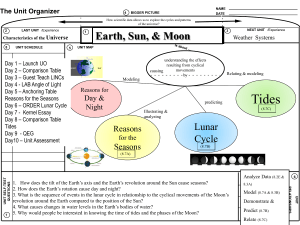Tides Web Activity Worksheet
advertisement

Tides Web Activity Instructions: Click on the link below, watch the video and answer the questions below. http://oceanexplorer.noaa.gov/edu/learning/player/lesson10.html Lesson: 1. What causes tides? Gravitational pull of sun and moon on earth. 2. What is the highest normal point called? High Tide 3. What is the lowest normal point called? Low Tide 4. What is the difference between these points called? Tidal Range 5. What are tidal bulges? The pulling of the earth’s oceans toward the moon and sun, follows the moon 6. Which exerts more tidal force (moon or sun)? Moon: more than twice as much 7. What are spring tides? Under what circumstances do they occur? The highest high tides and lowest low tides. Created by the moon and sun pulling in the same direction. 8. What are neap tides? Under what circumstances do they occur? Smallest high and low tides. Created when the sun and moon are at right angles to each other. 9. What are the four subdivisions of the intertidal zone? Spray Zone: wetted by the spray of the ocean, rarely submerged, supports very limited life Upper Intertidal Zone: Underwater only during high tide, Mid Intertidal Zone: Mostly submerged except during brief periods of low tide Low Intertidal Zone/subtidal Zone: only exposed to air during the “Lowest Low Tides” of the moon cycle 10. Give one example of an adaptation of an organism due to hits intertidal zone location? Tough leather-like leaves, grow in clumps so only top layer is exposed to sunlight, clams and shells close up to avoid being dried out. Animals that move hide and burry themselves. Must be able to sustain harsh waves. Thick skin, suck-like feet/grips, thick shells, cement themselves to each other and rocks, flexible, seaweeds move with water, fish are heavily boned, thick skin. Instructions: Click on the “Global Impact” Heading, watch the video and answer the questions below. Global Impact 1. What percentage of energy needed to power global circulation comes from the tides? Half of the energy comes from tides 2. How do the tides affect humans living on the coast Large tidal ranges can increase damages during hurricanes 3. Explain how we can harness tidal power. Offshore turbines Instructions: Click on “activities” on the right, go through each step and answer the questions: Step 1: Lunar Day 1. How much time passes between one high tide and the next? The tides are caused mainly by the gravitational attraction between the moon and the earth, so the spacing between tides will depend on the length of the lunar day. Since the lunar day is 24 hours and 50 minutes long and the earth rotates through two tidal bulges in that time, high tides will be spaced 12 hours and 25 minutes apart. 2. How much time passes between low tide and the next high tide? High tides are 12 hours and 25 minutes apart and are separated by a low tide. So low tide must come 6 hours and 12.5 minutes after one high tide and before the next. Step 2: Position of the Sun and Moon 1. Explain how spring and neap tides are created The tides are created by the pull of the moon and the sun. When those bodies are aligned with one another, their gravitational forces act in the same direction and reinforce one another, creating the maximum possible tidal bulges, called the spring tides. When the sun and moon are at 90 o from one another, relative to Earth, their tidal forces are also pulling in different directions, so the neap tides are minimized. 2. How many spring and neap tides occur each month? Why? There are 2 spring and 2 neap tides each month. The moon rotates around the earth once in a month, so in that time it will be aligned with the sun twice, and at 90o to the sun twice. Step 3: Orbital Shape 1. Why does the distance from the earth to the moon or fun affect the tides? The tide generating force depends on the mass of an object and its distance. As the distance between the earth and the moon or sun changes, the tidal force each produces will vary. 2. When will lunar tides be higher, at perigee or apogee? How often does each occur? The lunar tides will be highest when the moon is closest to the earth, a point in the moon’s orbit that is called perigee. It takes the moon a month to complete an orbit, so perigee will happen about once a month. 3. When will solar tides be higher, at perihelion or aphelion? How often does each occur? The solar tides will be highest when the sun is closest to the earth, a point in the earth’s orbit that is called perihelion. It takes the earth a year to complete an orbit around the sun, so perihelion will happen once a year. Step 4: Be the Captain 1. Describe the conditions that made a safe trip possible? January, Perigee and the new moon produce the lowest low tide. 2. Your sister ship will have to wait to make the same attempt until you unload your cargo and clear the dock. If you leave on a high tide that crests at noon, when should your fellow captain make his move? If the dock becomes clear at noon, the subsequent low tide will follow 6 hours and 12.5 minutes later. So the other captain should try to pass under the bridge just after 6 p.m. Instructions: Click on “Life in the Intertidal Zone”, read the information and answer the questions 1. How does the abundance and diversity of life change across the various intertidal zones? Life is very abundant and very diverse in the lower intertidal, and becomes less diverse towards the high intertidal. Both diversity and abundance are lowest in the spray zone. 2. Describe how the physical stresses on life vary from the top of the intertidal zone to the bottom? At the top of the intertidal zone, organisms spend more time exposed than underwater, so they will have to cope with desiccation and large temperature swings. Those pressures will be less important lower in the intertidal zone because of the protection provided by greater time underwater. But plants and animals there are at, or just below, the surf zone, so they will be pounded by waves. 3. How are these stresses reflected in the types of animals that inhabit the intertidal subzones? Many of the creatures that live in the highest intertidal zones either have the ability to close themselves up into their shells as a shelter against drying out, or are mobile enough to take cover. In the lower parts of the intertidal zone, many animals and plants have a means of attaching themselves in place and are either very sturdy or very flexible to stand up to wave energy. 4. Living conditions in the intertidal zone are difficult, yet most of it is abundantly populated. What are some of the benefits of intertidal living? The harsh conditions in the intertidal zone cut down on competition for food and for space by excluding many animals. And the shallow water transmits the sunlight for bottom-dwelling plants’ need for photosynthesis.








